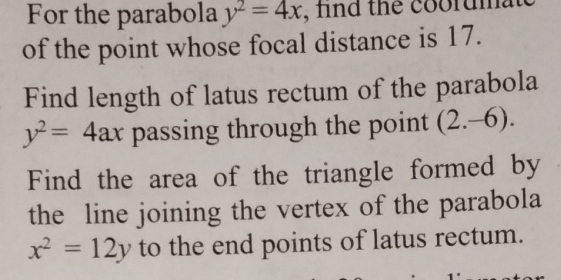For the parabola y^2 = 4x, find the coordinate of the point whose focal distance is 17. Find length of latus rectum of the parabola y^2 = 4ax passing through the point (2, -6). Fin... For the parabola y^2 = 4x, find the coordinate of the point whose focal distance is 17. Find length of latus rectum of the parabola y^2 = 4ax passing through the point (2, -6). Find the area of the triangle formed by the line joining the vertex of the parabola x^2 = 12y to the end points of latus rectum.

Understand the Problem
The question consists of three parts related to the properties of parabolas. It asks for the coordinate of a point based on the focal distance of a given parabola, the length of the latus rectum for another parabola through a specific point, and the area of a triangle formed by certain points related to a different parabola.
Answer
The point satisfying the focal distance split leads to the equation \(289 = (x - 1)^2 + y^2\); latus rectum length is \(18\); triangle area is \(36\).
Answer for screen readers
The coordinates of the point with a focal distance of 17 are defined by the equation (289 = (x - 1)^2 + y^2).
The length of the latus rectum for the parabola is (18).
The area of the triangle is (36).
Steps to Solve
- Finding the focal distance for the first parabola
For the parabola $y^2 = 4x$, the focus is located at $(1, 0)$. The focal distance is defined by the formula: $$ d = \sqrt{(x - 1)^2 + y^2} $$
Setting $d = 17$, we get: $$ 17 = \sqrt{(x - 1)^2 + y^2} $$
Squaring both sides: $$ 289 = (x - 1)^2 + y^2 $$
This is the equation we will solve.
- Finding the length of the latus rectum for the second parabola
For the parabola $y^2 = 4ax$, the length of the latus rectum is given by $4a$.
To find the value of $a$ for the parabola passing through the point $(2, -6)$, we substitute $x = 2$ and $y = -6$ into $y^2 = 4ax$: $$ (-6)^2 = 4a(2) $$ $$ 36 = 8a $$ $$ a = \frac{36}{8} = 4.5 $$
Now, the length of the latus rectum is: $$ 4a = 4 \times 4.5 = 18 $$
- Finding the area of the triangle formed by the third parabola
For the parabola $x^2 = 12y$, the vertex is at the origin $(0,0)$. The latus rectum endpoints can be found using the formula $x^2 = 12y$, where $x = \pm 6$ (since $l = 4p = 12$).
The endpoints are: $$ (6, 6) \quad \text{and} \quad (-6, 6) $$
Now, to find the area of the triangle formed by these points, we can use the formula for the area of a triangle given vertices at $(x_1, y_1)$, $(x_2, y_2)$, and $(x_3, y_3)$: $$ \text{Area} = \frac{1}{2} \left| x_1(y_2-y_3) + x_2(y_3-y_1) + x_3(y_1-y_2) \right| $$
Here:
- Vertex at the origin $(0,0)$
- Point 1 at $(6, 6)$
- Point 2 at $(-6, 6)$
Substituting: $$ \text{Area} = \frac{1}{2} \left| 0(6-6) + 6(6-0) + (-6)(0-6) \right| $$
Calculating this gives: $$ \text{Area} = \frac{1}{2} \left| 0 + 36 + 36 \right| = \frac{1}{2} \times 72 = 36 $$
The coordinates of the point with a focal distance of 17 are defined by the equation (289 = (x - 1)^2 + y^2).
The length of the latus rectum for the parabola is (18).
The area of the triangle is (36).
More Information
For parabolas in the form $y^2 = 4px$, the focus is at $(p, 0)$, and for $x^2 = 4py$, the focus is at $(0, p)$. The latus rectum is a key characteristic as it helps define the width of the parabola.
Tips
- Forgetting to square the distance when setting up the equation for focal distance can lead to errors.
- Not substituting correctly when calculating the latus rectum from a point can result in an incorrect value for $a$.
AI-generated content may contain errors. Please verify critical information